Question
The High Environmental Costs of Cruise Ships From garbage disposal to poisonous paint to the emission of noise that can harm marine life, cruise ships
The High Environmental Costs of Cruise Ships
From garbage disposal to poisonous paint to the emission of noise that can harm marine life, cruise ships pose numerous environmental challenges.
James MacDonald is the author of this piece. 1st of July 2019 Cruise ships have been compared to floating cities because they are frequently hundreds of feet long and carry thousands of guests and crew. However, all of those individuals consume resources and generate garbage. Carnival Cruises was fined $20 million for unlawful trash disposal, demonstrating that the industry is not above breaking environmental rules. The fine was only one of several environmental issues that the sector has had to deal with over the years. What is a cruise ship's environmental impact?
On the world's largest cruise ship, how is waste handled? The world's largest cruise ship produces a lot of rubbish with its 6,600 guests. Cruise lines are now designing ships that can handle waste from within, in an industry that has long been criticized for inadequate waste practices. The Symphony of the Seas, according to Royal Caribbean, is a zero-landfill ship, which means that everything is recycled, purified with water-purification systems, burnt, or transferred to a waste-to-energy facility. Business Insider visited the ship's hidden crew-only room below deck to observe how millions of pounds of water, food, and dry waste are handled each year.
The Problem Cruise ships have been referred to as "floating cities," and they, like cities, have significant environmental issues. Due to inadequate pollution control regulations, lax enforcement, and the difficulty of identifying illicit discharges at sea, their per capita pollution is actually worse than that of a city of the same population. Coastal waterways in Alaska, California, Florida, and Hawaii are all affected by cruise ships. The following categories of garbage are generated by all cruise ships: "Gray water" originating from sinks, showers, laundries, and galleys Toilet sewage or "black water"
Oily bilge water
Hazardous wastes (including perchloroethylene from dry cleaning, photo-processing wastes, paint waste, solvents, print shop wastes, fluorescent light bulbs, and batteries) Waste that is solid (plastic, paper, wood, cardboard, food waste, cans, and glass) Pollution of the air caused by the ship's diesel engines, particularly those that use heavy fuel oil (high sulphur content) Polluted discharge from sulphur oxide scrubber washwater effluent comprising gasoline, lubricants, and chemical additives (where utilised, see regulations section below for details).
On a typical one-week trip, a 3,000-passenger cruise ship (considered an average size; some carry 5,000 or more passengers) generates the following amounts of garbage, according to the Bureau of Transportation Statistics: 1 million gallons of "grey water"
210,000 gallons of sewage
25,000 gallons of greasy bilge water over 100 gallons of dangerous or poisonous waste (in 2017 this was changed to 16 tons) Diesel exhaust emissions and ultrafine particles at levels comparable to those found in heavily polluted metropolitan areas.
Due to their sheer size, cruise ships can do significant damage to nearby ecosystems in addition to manufacturing and discharging these waste products. While cruise ships come in different sizes, there is a noticeable trend toward larger ships, which may necessitate ports increasing the frequency and depth of dredge projects (actually excavating their channels and ports deeper to suit larger, deeper vessels), which can devastate local habitats. The passing of cruise ships, even without dredging, can have an influence on bottom dwelling organisms and generate severe turbidity by churning up silt.
You must tackle the problem as an environmental engineer using the job description and responsibilities listed below??????
Environmental engineers usually carry out the following tasks: Reports on environmental investigations are prepared, reviewed, and updated. Create projects that protect the environment, such as water reclamation plants or air pollution control systems. Obtain, maintain, and update plans, permits, and standard operating procedures.
Hints on the report
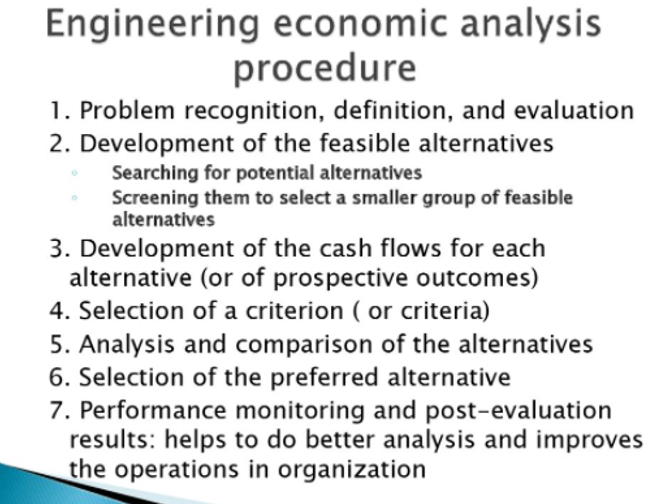
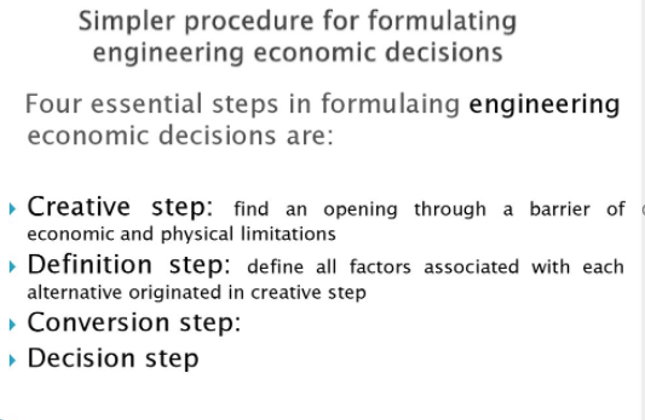

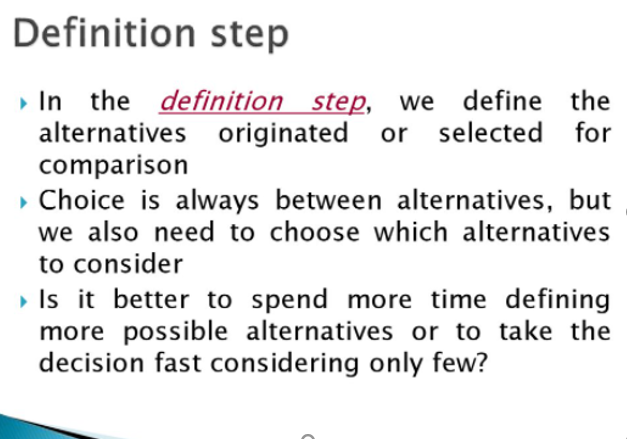
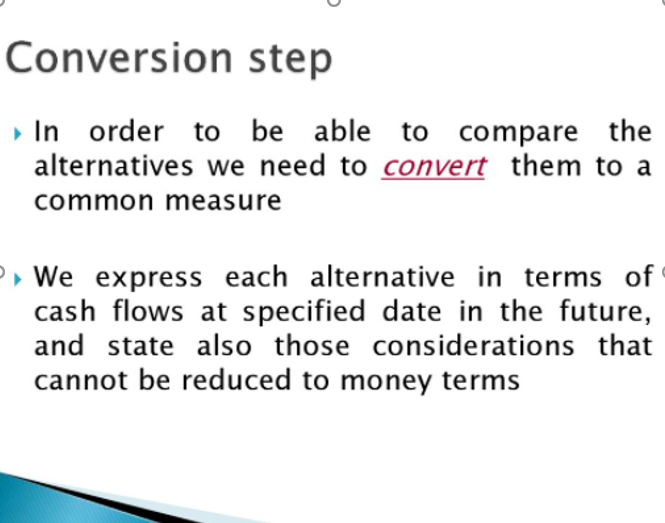
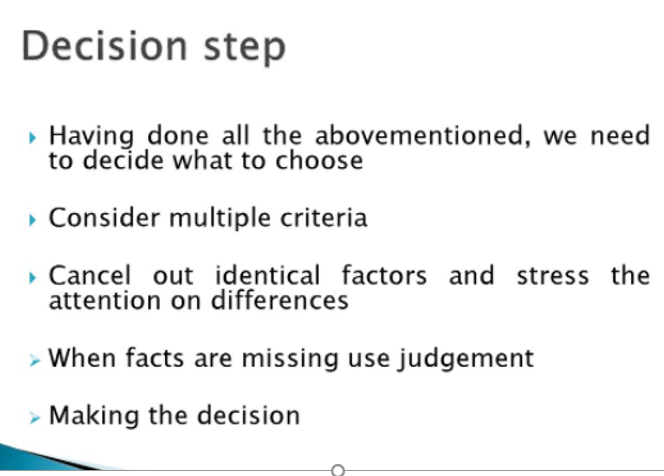
Engineering economic analysis procedure 1. Problem recognition, definition, and evaluation 2. Development of the feasible alternatives Searching for potential alternatives Screening them to select a smaller group of feasible alternatives 3. Development of the cash flows for each alternative (or of prospective outcomes) 4. Selection of a criterion (or criteria) 5. Analysis and comparison of the alternatives 6. Selection of the preferred alternative 7. Performance monitoring and post-evaluation results: helps to do better analysis and improves the operations in organization Simpler procedure for formulating engineering economic decisions Four essential steps in formulaing engineering economic decisions are: Creative step: find an opening through a barrier of economic and physical limitations Definition step: define all factors associated with each alternative originated in creative step Conversion step: Decision step Creative step The creative step consists of finding an opening through a barrier of economic and physical limitations (ex. aluminum discovery or mining) We explore, investigate and research aiming at finding new opportunitites Many successful ideas are simply new combinations of known facts Definition step In the definition step, we define the alternatives originated or selected for comparison Choice is always between alternatives, but we also need to choose which alternatives to consider Is it better to spend more time defining more possible alternatives or to take the decision fast considering only few? Conversion step In order to be able to compare the alternatives we need to convert them to a common measure We express each alternative in terms of cash flows at specified date in the future, and state also those considerations that cannot be reduced to money terms Decision step Having done all the abovementioned, we need to decide what to choose Consider multiple criteria Cancel out identical factors and stress the attention on differences When facts are missing use judgement Making the decision Engineering economic analysis procedure 1. Problem recognition, definition, and evaluation 2. Development of the feasible alternatives Searching for potential alternatives Screening them to select a smaller group of feasible alternatives 3. Development of the cash flows for each alternative (or of prospective outcomes) 4. Selection of a criterion (or criteria) 5. Analysis and comparison of the alternatives 6. Selection of the preferred alternative 7. Performance monitoring and post-evaluation results: helps to do better analysis and improves the operations in organization Simpler procedure for formulating engineering economic decisions Four essential steps in formulaing engineering economic decisions are: Creative step: find an opening through a barrier of economic and physical limitations Definition step: define all factors associated with each alternative originated in creative step Conversion step: Decision step Creative step The creative step consists of finding an opening through a barrier of economic and physical limitations (ex. aluminum discovery or mining) We explore, investigate and research aiming at finding new opportunitites Many successful ideas are simply new combinations of known facts Definition step In the definition step, we define the alternatives originated or selected for comparison Choice is always between alternatives, but we also need to choose which alternatives to consider Is it better to spend more time defining more possible alternatives or to take the decision fast considering only few? Conversion step In order to be able to compare the alternatives we need to convert them to a common measure We express each alternative in terms of cash flows at specified date in the future, and state also those considerations that cannot be reduced to money terms Decision step Having done all the abovementioned, we need to decide what to choose Consider multiple criteria Cancel out identical factors and stress the attention on differences When facts are missing use judgement Making the decision
Step by Step Solution
There are 3 Steps involved in it
Step: 1

Get Instant Access to Expert-Tailored Solutions
See step-by-step solutions with expert insights and AI powered tools for academic success
Step: 2

Step: 3

Ace Your Homework with AI
Get the answers you need in no time with our AI-driven, step-by-step assistance
Get Started


